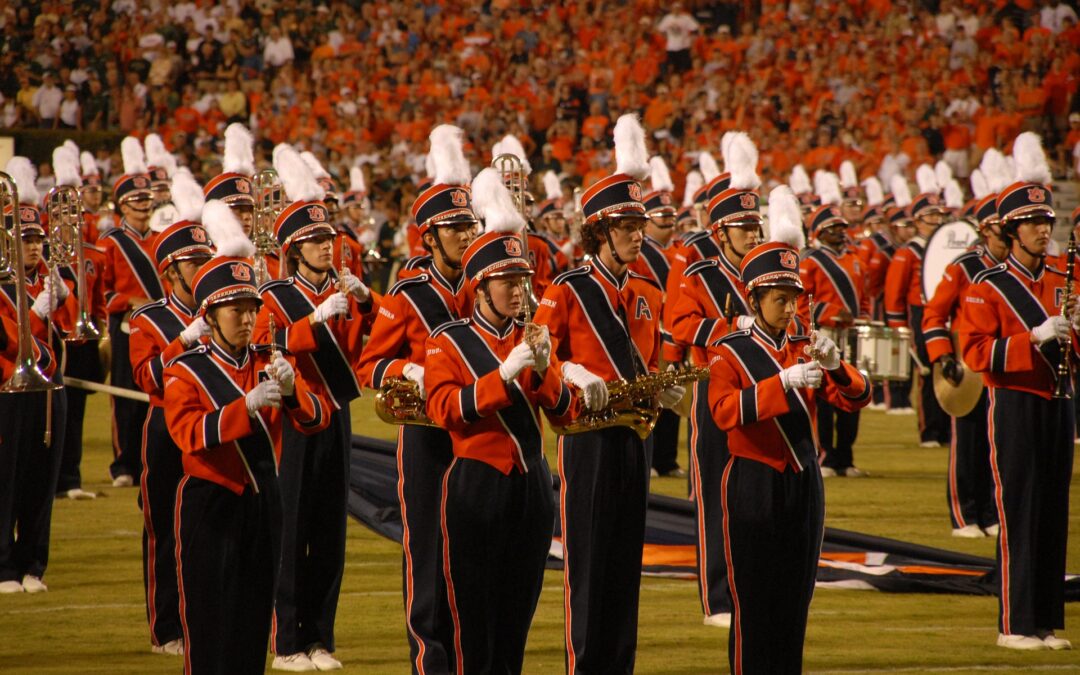Collegiate Marching Band Artists Experience High Core Body Temperatures during Rehearsals and Performances
Emerson DM, Torres-McGehee TM, Yeargin SW, Kelly MR, Uriegas N, Smith A, Weber SR, Hirschhorn RM, Cannon C. J Athl Train. 2020 Dec 22;2020(preprint):0. doi: 10.4085/JAT0245-20.Online ahead of print.
Core Body Temperatures in Collegiate Marching Band Artists During Rehearsals and Performances
Emerson DM, Torres-McGehee TM, Yeargin SW, Kelly MR, Uriegas N, Smith A, Weber SR, Hirschhorn RM, Cannon C. J Athl Train. 2021 Feb 18. doi: 10.4085/1062-6050-0245.20. Epub ahead of print.
Take-Home Message
Marching band artists exhibited high core body temperature and had several risk factors for exertional heat illness.
Background
Collegiate marching band artists perform many of the same demanding musculoskeletal tasks as student-athletes; however, they lack medical support to treat and prevent injuries or illnesses. For example, many marching band artists complete preseason activities in the heat; yet lack proper hydration and acclimatization strategies. Unfortunately, clinicians lack basic information to confirm if these artists are at risk of exertional heat illness.
Study Goal
The authors evaluated marching band artists to examine core body temperature and other physiological measures during rehearsals and football game performances. They also assessed risk factors for exertional heat illness among this group.
Methods
Nineteen marching band artists from 2 different marching bands completed all of the study’s components across 5 days (3 outdoor rehearsals and 2 home-game football performances). On game days, the artists completed a pre-game morning rehearsal and later performed at the game. First, the authors performed anthropometric measurements (height, mass, body fat percental, body surface area). Then, the authors recorded the physical activity in minutes and categorized them (e.g., warm-up, standing with instruments, standing without instruments, high step march, rest/break). To assess body temperature every 15 minutes through rehearsals and performances, participants ingested a pill ~6 hours before data collection. Participants also provided a urine sample before and after each session. Then, the authors evaluated hydration status using % body mass, urine specific gravity, and sweat rate. The authors also assessed perceived thirst before and after activity on a scale from 1 (not thirsty at all) to 9 (very, very thirsty). They also measured wet-bulb globe temperature and relative humidity every 15 minutes and documented type of ground surface. Lastly, the marching band artists completed a pre-activity questionnaire before each rehearsal or performance to report any medication/supplements, sleep quantity, and any signs or symptoms of illness.
Results
Marching band artists exhibited increased core temperature post-rehearsal (~38.3 oC) compared to pre-rehearsal (~37.8 oC). There were no differences in core temperature from pre-game to post-game. However, 5 out of 19 artists experienced core temperatures >40°C for at least 60 minutes during games. Over half (63%) of the marching band artists came to games in a hypohydrated state. In contrast, most of the time (76%), they had normal hydration levels coming into rehearsals. Whether the artists drank enough fluids to match sweat rates is unclear because the 2 papers disagree. However, they experienced no meaningful loss in percent body mass. Lastly, the authors found higher core body temperature was associated with environmental factors (i.e., max wet-bulb globe temperature and relative humidity, ground surface), using mental health medications, and hours of sleep.
Viewpoints
The authors confirmed that marching band artists experience elevated core body temperatures similar to football players (~38 oC). However, we can infer that the artists drank enough fluids during rehearsals and games because, on average, they experienced no clinically meaningful body mass changes. Clinicians should be concerned though because 2 in 3 artists came to games hypohdrated. Furthermore, the artists completed 2 rehearsals and 3 games when activity guidelines based on wet globe temperature suggested no activity. Lastly, larger studies will be needed to clarify risk factors for exertional heat illness among marching band artists.
Clinical Implications
Medical professionals should be aware of the mechanisms that drive marching band artists to suffer from exertional heat illnesses as well as the additional risk factors that could play a role in increasing their risk for this condition. Medical professionals should work with band administrators to develop appropriate exertional heat illness prevention and management strategies to ensure these artists receive appropriate education and medical care.
Questions for Discussion
Does your setting work with marching band artists? If not, will you consider reaching out? Why or why not?
Related Posts
- Clinical Pearl: Prevention and Treatment of Exertional Heat Stroke
- Cheers! The More you Move, The More You Need To Drink
- Following Guidelines to Prevent Exertional Heat Illness? Let’s Reconsider Those Guidelines
Written by: Jane McDevitt
Reviewed by: Jeffrey Driban


